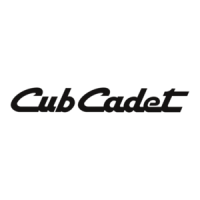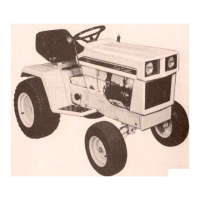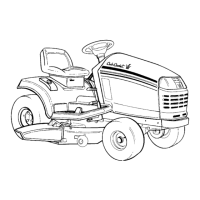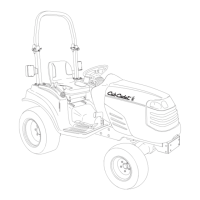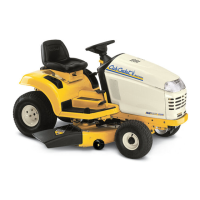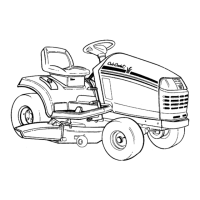CVT Drive and brake system
57
About this chapter
The drive and brake systems for the Cub Cadet Series
1000 tractor are combined. Two reasons for this:
• The brake on the Series 1000 tractor is supplied
with the transaxle.
• The brake pedal applies the brake and disen-
gages the drive system. Both systems share
common linkage.
The transaxle used in the Cub Cadet Series 1000 is a
relatively simple gearbox containing forward, neutral,
and reverse gears. The variation in speed is all han-
dled by the variable speed pulley system that drives
the transaxle.
If the tractor has drive system problems within the war-
ranty period, the servicing Cub Cadet dealer has the
following responsibilities:
• Eliminate any external causes for drive system
problems before removing the transmission from
the tractor.
• External problems would include, but are not lim-
ited to: belt, linkage, or brake issues.
• Look for signs or over-use or abuse.
Transaxles that fail because of over use or
abuse are not warrantable. They are to be
repaired or replaced at the customer’s expense.
• If the problem is internal, the transmission is to
be replaced under the like-kind exchange policy.
• If a transaxle is replaced under warranty, the
original transaxle may be called-back for evalua-
tion by MTD Vendor Recovery Dept.
• Warranty Claims will be denied, returned, or
adjusted if the returned transaxle does not meet
Cub Cadet’s replacement criteria.
• Dealers are encouraged to open transaxles for
inspection, allowing them to identify a problem
within the transaxle.
• Beyond warranty, dealers are free to repair
transmissions at customer expense.
• If the dealer has questions regarding transaxle
replacement, they should call Cub Cadet Ser-
vice using the dealer only line before proceed-
ing.
About the variable speed drive system.
There are two drive belts in the system. A long drive
belt transfers power from the engine crankshaft to the
lower sheave of the variable-speed pulley. A shorter
belt fits in the upper sheave of the variable speed pul-
ley; transferring power from there to the input pulley on
the transaxle.
• The drive control pedal tensions the front drive
belt.
• The center partition of the variable speed pulley
separates the lower (front) belt from the upper
(rear) belt.
• As the front belt is tensioned, it is drawn deeper
into its sheave. The effective circumference of
the driven pulley shrinks.
• As the front belt is drawn deeper into its sheave,
the center partition is forced upward, making the
upper shave narrower.
• As the upper sheave pinches-down on the rear
drive belt, the belt is forced outward in the
sheave. The effective circumference of the pul-
ley driving the rear belt grows.
• As the upper and lower sheaves change size,
the drive ratio shifts increasing the speed of the
rear belt.
• As the sheave that drives the rear belt changes
size, the belt must be kept under constant ten-
sion. A tension idler pulley accomplishes this
task.
• The clutch/brake pedal automatically de-ten-
sions the front belt when it is applied.
CHAPTER 6: CVT DRIVE AND BRAKE SYSTEM
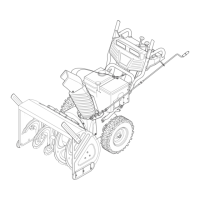
